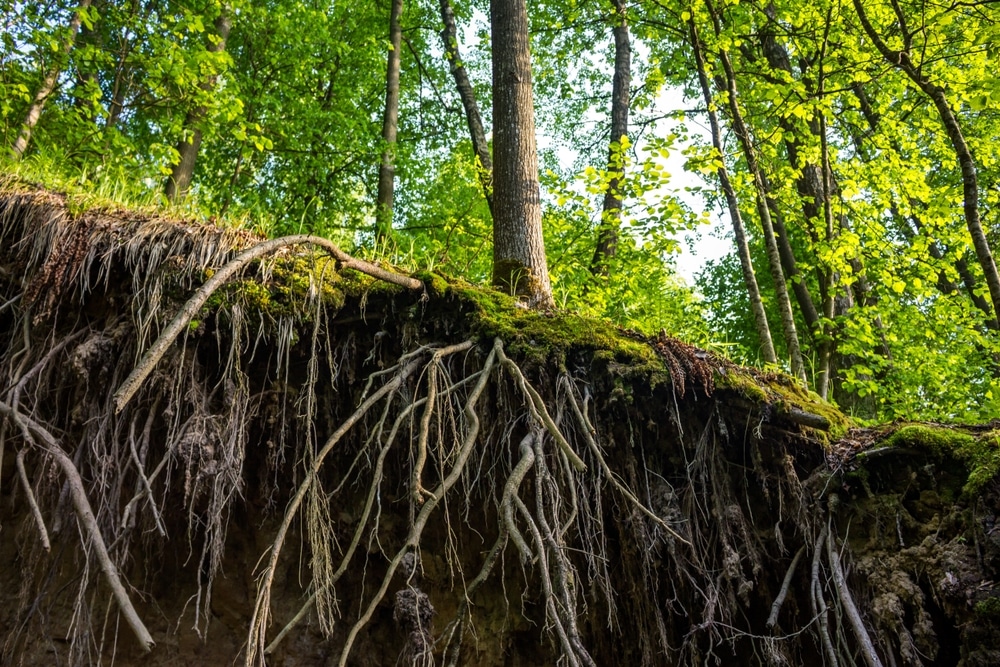When admiring a beautiful landscape or a majestic tree, it’s easy to forget about what’s happening underground. Beneath the surface, there is a complex network of roots that anchors and nourishes plants. Among these hidden structures, asymmetric root systems—roots that grow more on one side than the other—play a crucial role in helping plants grow, stay stable, and adapt to different environments. Understanding these underground networks isn’t just a matter of curiosity; it’s essential for successful landscaping and keeping plants healthy long-term.
At Environmental Design Inc., we specialize in choosing and supplying trees with strong, well-adapted root systems for various projects. Our knowledge of asymmetric root systems allows us to offer solutions for challenging landscapes, ensuring your plants stay healthy and stable over time.
In this blog post, we’ll uncover the fascinating world of asymmetric root systems, covering their basic structure, what makes them special, what affects their development, and how they can be practically used in landscaping. Whether you’re a homeowner, landscaper, or environmental enthusiast, by the end, you’ll understand how these underground powerhouses can improve your landscaping projects and create more resilient, sustainable green spaces.
Understanding Root Systems
Before we dive into the details of asymmetric root systems, let’s first understand the basics of root structures and their key roles in a plant’s life.
The Foundation of Plant Life
Root systems are the foundation of plant life and serve several important purposes:
- Anchorage: Roots hold plants in the ground, keeping them steady against strong winds or other environmental forces.
- Nutrient absorption: Roots take in water and essential nutrients from the soil, which are vital for the plant’s survival.
- Storage: Some roots store food (carbohydrates) and other nutrients, acting as a backup for the plant.
- Symbiotic relationships: Roots often form partnerships with microorganisms in the soil, which helps the plant absorb more nutrients.
Types of Root Systems
There are two main types of root systems:
- Taproot systems: These have one large, central root that grows downward (like a carrot) with smaller side roots branching out. Examples include carrots, dandelions, and trees like oaks and pines.
- Fibrous root systems: These consist of many thin roots of similar size that spread out in all directions. Grasses and some trees, like maples, have fibrous root systems.
Understanding these basic types helps us appreciate the unique qualities of asymmetric root systems and their adaptations to specific environmental conditions.
The Unique Architecture of Asymmetric Root Systems
Asymmetric root systems are roots that don’t spread evenly around the plant. Instead, they grow more on one side or in the direction where the plant needs extra support or resources.
Defining Asymmetry in Root Systems
Asymmetric root systems are characterized by an uneven distribution of roots around the plant’s central axis. Unlike symmetric systems where roots spread evenly in all directions, asymmetric roots may develop more extensively on one side of the plant or in specific directions.
Key features include:
- Uneven root growth on different sides
- Varied root lengths and thicknesses
- Growth that favors certain directions
Adaptations and Advantages
The unique structure of asymmetric roots offers several benefits:
- Enhanced stability: Asymmetric roots grow more in areas where the plant needs extra support, like on a slope or in windy conditions, helping the plant stay anchored.
- Efficient resource gathering: These roots can grow toward areas where there’s more water or nutrients.
- Stress response: Asymmetric roots can adapt to stress, such as wind or steep slopes, by growing more in the needed areas for support.
The Role of Asymmetric Cell Divisions
At the cellular level, asymmetric root systems start with asymmetric cell divisions in the root’s growth area (called the root meristem). This creates cells that grow into different types of roots, guiding the overall root structure and how it adapts to environmental changes.
Factors Influencing Asymmetric Root System Development
The development of asymmetric root systems depends on several environmental factors that influence how they grow. Knowing these factors is important for successful landscaping and plant management.
Soil Composition and Structure
The type of soil plays a major role in how roots grow:
- Soil texture: Sandy soils encourage deeper roots, while clay soils often result in shallower, more spread-out roots.
- Soil compaction: Hard, compacted soils can restrict root growth, causing roots to develop unevenly as they find paths of least resistance.
- Nutrient distribution: If nutrients are unevenly spread in the soil, roots will grow more in the areas where there are more nutrients.
Water Availability
Water is also a huge key factor that drives root growth patterns:
- Drought conditions: In dry environments, roots grow deeper or spread wider to find water.
- Excess water: In wet conditions, roots tend to stay shallow, as they don’t need to go far for water.
- Water gradients: If water is distributed unevenly in the soil, roots will grow unevenly to reach the water-rich areas.
Mechanical Resistance
Physical barriers and soil resistance also affect root growth:
- Rocks and obstacles: Roots grow around obstacles like rocks, which can create uneven root growth.
- Soil layers: Differences in soil density at various depths can cause roots to grow in layers or develop asymmetrically.
- Slopes: Plants on slopes often develop asymmetric root systems to improve their stability on the incline.
Environmental Stimuli and Plant Responses
Plants with asymmetric root systems demonstrate remarkable adaptability to environmental challenges. Two key factors that shape these adaptations are wind stress and nutrient distribution.
Wind Stress and Root Adaptation
Wind exposure can significantly influence root system development:
- Mechanical stimulation: Constant wind pressure acts like a natural signal to the plant, triggering roots to grow more on the side that faces the wind (the windward side). This extra root growth helps anchor the plant firmly in the ground, providing greater stability.
- Thigmomorphogenesis: This is a scientific term for how plants change their growth patterns in response to physical forces, like the pressure from the wind. When a plant is regularly exposed to wind, its root system can become stronger and more resilient, much like how muscles become stronger with regular exercise.
- Anchorage enhancement: As a result of these processes, asymmetric root growth can significantly improve a plant’s ability to stay upright and stable during strong winds. Instead of growing evenly in all directions, the roots grow more where they are needed to counteract the wind’s force.
Nutrient Distribution and Root Foraging
Roots actively seek out nutrients in the soil:
- Root proliferation: In areas of the soil that are rich in nutrients, roots will grow more extensively. Think of it as the plant “foraging” for food—it sends more roots into areas where it finds plenty of nutrients.
- Selective growth: When soil conditions are uneven, with some areas richer in nutrients than others, plants often grow their roots asymmetrically, focusing on the nutrient-dense patches. This helps the plant make the most of its surroundings without wasting energy growing roots in poor soil.
- Adaptive strategies: In environments where the soil is poor or uneven, plants with asymmetric root systems can adapt by altering their root architecture. For example, in dry or nutrient-scarce areas, these plants might grow deeper or wider roots to maximize their ability to find water and nutrients, ensuring survival in tough conditions.
By adjusting their root systems in response to environmental factors like wind and nutrient availability, plants can thrive even in less-than-ideal environments. These adaptations not only help the plant grow but also contribute to overall stability, resilience, and health, especially in challenging landscapes.
Practical Applications in Landscaping
Understanding asymmetric root systems has significant implications for landscaping practices, particularly in tree selection and placement.
Leveraging Asymmetric Root Systems for Better Tree Selection
When selecting the right trees for a specific landscape, it’s helpful to consider how their roots grow:
- Choosing trees based on location: Trees with uneven root growth are often better suited for challenging landscapes, like areas with uneven ground or difficult soil.
- Stability in windy areas: In places that experience strong winds, trees with asymmetric roots (roots that grow more on one side) can offer better stability and are less likely to topple.
- Maximizing space: Knowing how a tree’s roots grow can help in planning the layout of your landscape. For example, planting trees with asymmetric roots can prevent damage to sidewalks or building foundations by ensuring their roots don’t grow into those areas.
Enhancing Landscape Stability Through Root System Knowledge
Using knowledge of asymmetric root systems in your landscape design can create greener spaces that are more durable and better suited to the environment:
- Preventing erosion: Planting trees with asymmetric roots on slopes can help keep the soil in place and prevent erosion.
- Urban planning: In cities, choosing trees with roots that grow in certain directions can reduce the risk of roots damaging pavements and underground pipes.
- Protection during storms: In areas prone to storms or floods, trees with strong, asymmetric roots can stay firmly in place, providing more stability and protection during extreme weather events. This helps make urban green spaces safer and last longer.
Conclusion
The hidden world of asymmetric root systems shows us nature’s clever way of solving environmental challenges. These underground structures not only help plants survive and grow but also make them more stable and efficient in tough conditions.
For landscapers, architects, and property owners, understanding asymmetric root systems opens up new possibilities for designing better landscapes. By factoring in how these root systems work, we can create greener, more sustainable, and balanced spaces that thrive in different environments.
As we continue to face environmental challenges, learning how to use asymmetric root systems in landscaping will become even more important. By working with nature, we can create beautiful green spaces that are not only visually appealing but also strong and adaptable to changing conditions.
Environmental Design Inc.
At Environmental Design Inc., we specialize in selecting and supplying trees with efficient rooting structures for a wide range of projects. Our team of experts can help you choose the perfect trees for your landscape, taking into account factors like soil conditions, climate, and specific site challenges.
Whether you’re planning a large-scale landscaping project or looking to enhance your property with strategically placed trees, we’re here to help. We custom grow trees with asymmetric root systems tailored for eventual installation, ensuring they thrive in their unique environments.
Contact us today to learn more about our tree supply services and how we can help you create beautiful, resilient green spaces.




Recent Comments